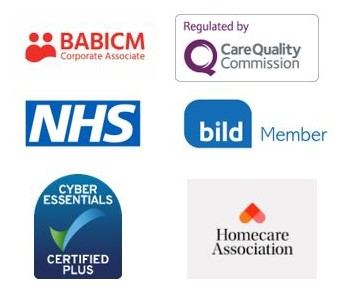Cerebral palsy and paediatric neurogenic bladder often occur alongside one another. Although most children living with cerebral palsy learn urinary control, over 50% live with a spectrum of lower urinary tract symptoms (Truong & Bani, 2018), meaning proactive and informed support is therefore needed as part of the child’s case management process to ensure they can cope, enjoy dignity, and their bladder health is maintained.
In this article, we explore the link between cerebral palsy and neurogenic bladder, the causes and signs of this, and how a child and their family can be supported.
Understanding the link between Cerebral Palsy and Neurogenic Bladder
Cerebral palsy is a neurological condition that is caused by damage or abnormal development in sections of the brain that control movement. Most children with cerebral palsy are born with the condition, known as congenital cerebral palsy, although a small number of children may have acquired cerebral palsy, which occurs more than 28 days after birth (NIH, 2016).
Children with cerebral palsy have limited control over their movement and coordination, presenting symptoms such as muscle weakness and stiffness; fidgety and jerky movements (NHS, 2023). There is often a correlation between children with muscle control and mobility issues and a paediatric neurogenic bladder.
A neurogenic bladder is a malfunctioning urinary bladder that is caused by a neurologic dysfunction caused by internal or external trauma, disease, or injury. For most children including those with cerebral palsy, the muscles and nerves in the urinary system work as one to carry messages from the brain to the bladder. However, children who have poor mobility and/or muscle control may experience a neurogenic bladder.
There are several urological issues associated with a neurogenic bladder such as:
- Urinary incontinence,
- Urinary retention,
- An increased risk of urinary tract infections (UTIs).
Due to the damage of the brain, children with cerebral palsy may have a delayed or diminished ability to sense a full bladder, making it difficult to maintain regular toileting schedules. Additionally, spasticity, a common symptom of cerebral palsy, can affect the bladder and sphincter muscles, complicating the process of urination.

A diagram showing innervation of the bladder.
Reproduced from Neurogenic Bladder. Caring for Persons with Spinal Cord Injury – e-learning resource for family physicians. Ontario Neurotrauma Foundation.
Nursing Strategies for Supporting Bladder Function in Children with Cerebral Palsy
Sarah Sandison is a Paediatric Nurse and Case Manager with over 10 years of experience in paediatric nursing and child development. She has specialised expertise in neurorehabilitation, and managing complex injuries, including hypoxic-ischemic brain injury, severe dystonia, and sensory impairments. Sarah’s background includes extensive work with conditions like cerebral palsy, neuromuscular disorders, and respiratory issues, where she has played a pivotal role in both surgical and non-surgical interventions to support the health and development of children.

Sarah Sandison, Registered Nurse and Case Manager at Empowering U Case Management.
Affiliated with CMSUK and the Nursing and Midwifery Council, Sarah is committed to providing comprehensive, family-centred care. She conducts thorough health-needs assessments in both home and school environments, offering tailored recommendations to enhance the well-being of each child. Sarah’s experience also includes acting as a Paediatric Nurse Expert Witness.
Below, Sarah shares her insights and strategies as a Paediatric Nurse, focusing on how these can be applied to support the complex health needs of children with cerebral palsy.
From the nurse’s point of view, it is important that the child gains as much independence as they are able, in taking care of their own toileting needs, and that their dignity can be maintained at all times. The nurse will perform a holistic assessment and help families navigate their way as they learn to manage their child’s bladder dysfunction until they feel competent.
Because the spectrum of disablement in a child with cerebral palsy is vast, the strategies and treatment plans can vary significantly. The aim is always for the nurse to empower the child to be able to manage their bladder dysfunction independently, however, with severely disabled children, it is the parents/carers who will be responsible for this.
There are many treatments used for neurogenic bladder ranging from nonsurgical and nonmedication-based therapies which the nurse can support, to surgical interventions. A non-invasive treatment which can be taught to the child if they are able, is to practise pelvic floor exercises thus strengthening their ability to hold urine, alongside a request that they, or their family, keep a diary recording when they have passed urine and the volume. This enables a more manageable pattern to be established.
Children are frequently treated with oxybutynin medication. This works by relaxing the muscles around the bladder, allowing it to hold more urine. This can help allow the child to maintain bladder control for longer and can be combined with supported toileting, whereby the child is prompted to go to the toilet at certain times.
Another regularly used treatment is intermittent catheterisation. This is a technique whereby a thin plastic tube is inserted into the bladder through the urethra, draining the bladder of urine. This will be done in regular intervals and is something that children’s nurses teach parents and children to do independently.
All these strategies depend on both the physical ability of the child and the level of dysfunction of the bladder. Maintaining bladder health is essential to prevent infection and this is taught to the patient and their family from the start of nursing involvement.
Occupational Therapy Strategies for Enhancing Bladder Function in Children with Cerebral Palsy
Angela Molnar is an Occupational Therapist (OT) and Case Manager with over 15 years of experience working with children and adults who have birth injuries or life-limiting conditions like cerebral palsy. Her extensive background includes roles within the NHS and Social Services, where she developed tailored treatment plans that address motor skills, sensory needs, and mental health.
Affiliated with the Health and Care Professions Council and the British Association of Occupational Therapists, Angela is dedicated to providing empathetic, client-centred care. She also offers training sessions to teachers and caregivers, helping them better understand and support the specific needs of children.
In the following section, Angela offers her insights and strategies as an OT, focussing on how these can be applied to support bladder function in children with cerebral palsy. When planning to work with a child towards the goal of promoting bladder function the following could be considered:
- The environment.
- Ability of the child in relation to sensory needs.
- The level of support.

Angela Molnar, Occupational Therapist and Case Manager at Empowering U Case Management.
The list of strategies we could consider is lengthy, but some are listed below.
Consideration would be given to the sensory system, in particular, the interoceptive sense; the sense that allows us to understand when our bladder is full. With children with Cerebral Palsy, this can be much more difficult to interpret and understand. In which case it is helpful to plan timed toileting, a schedule for the child and carers, which will detail a routine to access the toilet i.e. after meals, drinks, waking from sleep etc.
For the family and carers, this can be time-consuming, and all parties need to be on board when using the 24-hour planner. The schedule can be designed using picture cards and this will therefore allow the child to feel included with this strategy, and eventually, it would be hoped to promote some independence. Other reminders could include vibrating or auditory prompts such as alarms on phones, watches etc.
An assessment would need to be completed in terms of transfers, posture and balance, is the child able to transfer on/off the toilet and maintain an upright seated position. It may be that specialist equipment is required to support this and therefore a step and toileting seat (considering armrests/handles) may be required, allowing the child to access the toilet, and sit comfortably and safely. Ultimately, reducing anxiety or worry of falling off or into the toilet.
Assessment of the environment is also important considering: noise (bathrooms can be very echoey), lighting, positioning of the toilet, and privacy. Can we add anything to make it a more inviting place to be, playing music, using headphones, reading a story, creating a rewards chart etc. Again, all these may allow the child to feel more comfortable and spend an increased amount of time sitting and waiting for their bladder to open.
The approach for toileting needs to be holistic and address all concerns and difficulties identified, for us to work towards the goal of continence.
The Importance of Comprehensive Care
Managing bladder health in children with cerebral palsy is a continuous process that requires a comprehensive and individualised approach. At Empowering U Case Management, we recognise the importance of addressing urological health as part of a broader care plan.
Our dedicated team of healthcare professionals, including registered nurses, occupational therapists, and physiotherapists, works closely with individuals and their families to develop tailored strategies that promote good bladder health and overall well-being.
Ensuring that individuals with cerebral palsy receive the appropriate support and interventions can significantly enhance their quality of life, allowing them to lead more independent and comfortable lives.
References
NHS. (2023). Overview – Cerebral Palsy. NHS; NHS. https://www.nhs.uk/conditions/cerebral-palsy/
NIH. (2016, December). What causes cerebral palsy? https://www.nichd.nih.gov/health/topics/cerebral-palsy/conditioninfo/causes
Truong, H., & Bani, A. H. (2018). Neurogenic Bladder in Cerebral Palsy: Upper Motor Neuron. Springer EBooks, 1–17. https://doi.org/10.1007/978-3-319-50592-3_57-1




